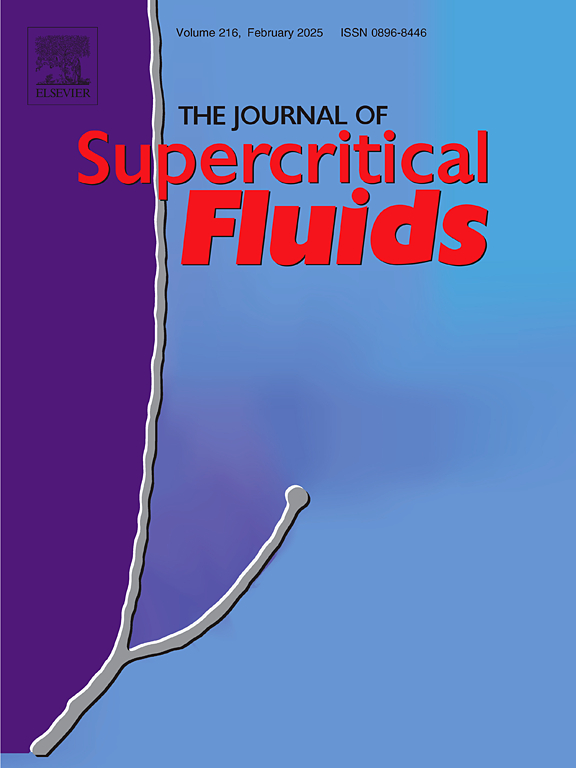Optimization and performance evaluation of equations of state for supercritical CO2-rich mixtures for application in the NET Power cycle
IF 4.4
3区 工程技术
Q2 CHEMISTRY, PHYSICAL
引用次数: 0
Abstract
In this paper the interaction parameters of six equations of state (EoS) were calibrated from density and phase equilibrium experimental data of supercritical CO2-rich mixtures. The Peng-Robinson (PR), Soave-Redlich-Kwong (SRK), Lee-Kesler-Plöcker (LKP), Benedict-Webb-Rubin-Starling (BWRS), perturbed chain SAFT (PC-SAFT) and Cubic-Plus-Association (CPA) EoSs were considered. As a novelty, the pressure, temperature and composition ranges for calibration were (1 – 49) MPa, (293.18 – 423.15) K, and (72.6 – 99.8) % mol CO2, which are close to those found in the innovative oxy-combustion NET Power cycle, particularizing the optimization of the EoSs for application in this power cycle. The performance of the EoSs, including the GERG-2008 EoS, was assessed in an isentropic compression process from 7.4 MPa to 30 MPa. The LKP EoS reported the lowest average deviation, 2.03 %, in modeling the bubble and dew lines of the supercritical CO2 – H2O mixture. The GERG-2008 EoS was the most reliable model capturing the density of the supercritical CO2-rich mixtures, reporting an average deviation of 1.34 %. Therefore, the combination GERG-2008 + LKP is recommended for NET Power cycle modeling purposes. Only the CPA and GERG-2008 models captured the liquid-like properties of the CO2-rich mixture during the compression. This resulted in a specific compression work of 33.02 kJ kg−1 for GERG-2008, while the PR, SRK, LKP, and PC-SAFT EoSs reported a value up to 1.54, 1.65, 1.53, and 1.70 times higher.
超临界富二氧化碳混合物在净功率循环中的状态方程优化与性能评价
本文根据超临界富二氧化碳混合物的密度平衡和相平衡实验数据,对6个状态方程的相互作用参数进行了标定。考虑了Peng-Robinson (PR)、Soave-Redlich-Kwong (SRK)、Lee-Kesler-Plöcker (LKP)、Benedict-Webb-Rubin-Starling (BWRS)、微动链SAFT (PC-SAFT)和cbr - plus - association (CPA) eos。作为一种新颖的方法,用于校准的压力、温度和成分范围分别为(1 ~ 49)MPa、(293.18 ~ 423.15)K和(72.6 ~ 99.8)% mol CO2,这与创新的全氧燃烧净动力循环中发现的结果接近,特别是针对该动力循环应用的eos优化。在7.4 MPa到30 MPa的等熵压缩过程中,对包括geg -2008型EoS在内的EoS的性能进行了评估。在模拟超临界CO2 - H2O混合物的气泡线和露珠线时,LKP EoS的平均偏差最小,为2.03 %。geg -2008 EoS是捕获超临界富二氧化碳混合物密度的最可靠模型,报告的平均偏差为1.34 %。因此,建议将ergg -2008 + LKP组合用于NET Power循环建模。只有CPA和geg -2008模型捕捉到了压缩过程中富含二氧化碳的混合物的液体性质。这导致geg -2008的特定压缩功为33.02 kJ kg−1,而PR、SRK、LKP和PC-SAFT eos的压缩值高达1.54、1.65、1.53和1.70倍。
本文章由计算机程序翻译,如有差异,请以英文原文为准。
求助全文
约1分钟内获得全文
求助全文
来源期刊

Journal of Supercritical Fluids
工程技术-工程:化工
CiteScore
7.60
自引率
10.30%
发文量
236
审稿时长
56 days
期刊介绍:
The Journal of Supercritical Fluids is an international journal devoted to the fundamental and applied aspects of supercritical fluids and processes. Its aim is to provide a focused platform for academic and industrial researchers to report their findings and to have ready access to the advances in this rapidly growing field. Its coverage is multidisciplinary and includes both basic and applied topics.
Thermodynamics and phase equilibria, reaction kinetics and rate processes, thermal and transport properties, and all topics related to processing such as separations (extraction, fractionation, purification, chromatography) nucleation and impregnation are within the scope. Accounts of specific engineering applications such as those encountered in food, fuel, natural products, minerals, pharmaceuticals and polymer industries are included. Topics related to high pressure equipment design, analytical techniques, sensors, and process control methodologies are also within the scope of the journal.
 求助内容:
求助内容: 应助结果提醒方式:
应助结果提醒方式:


